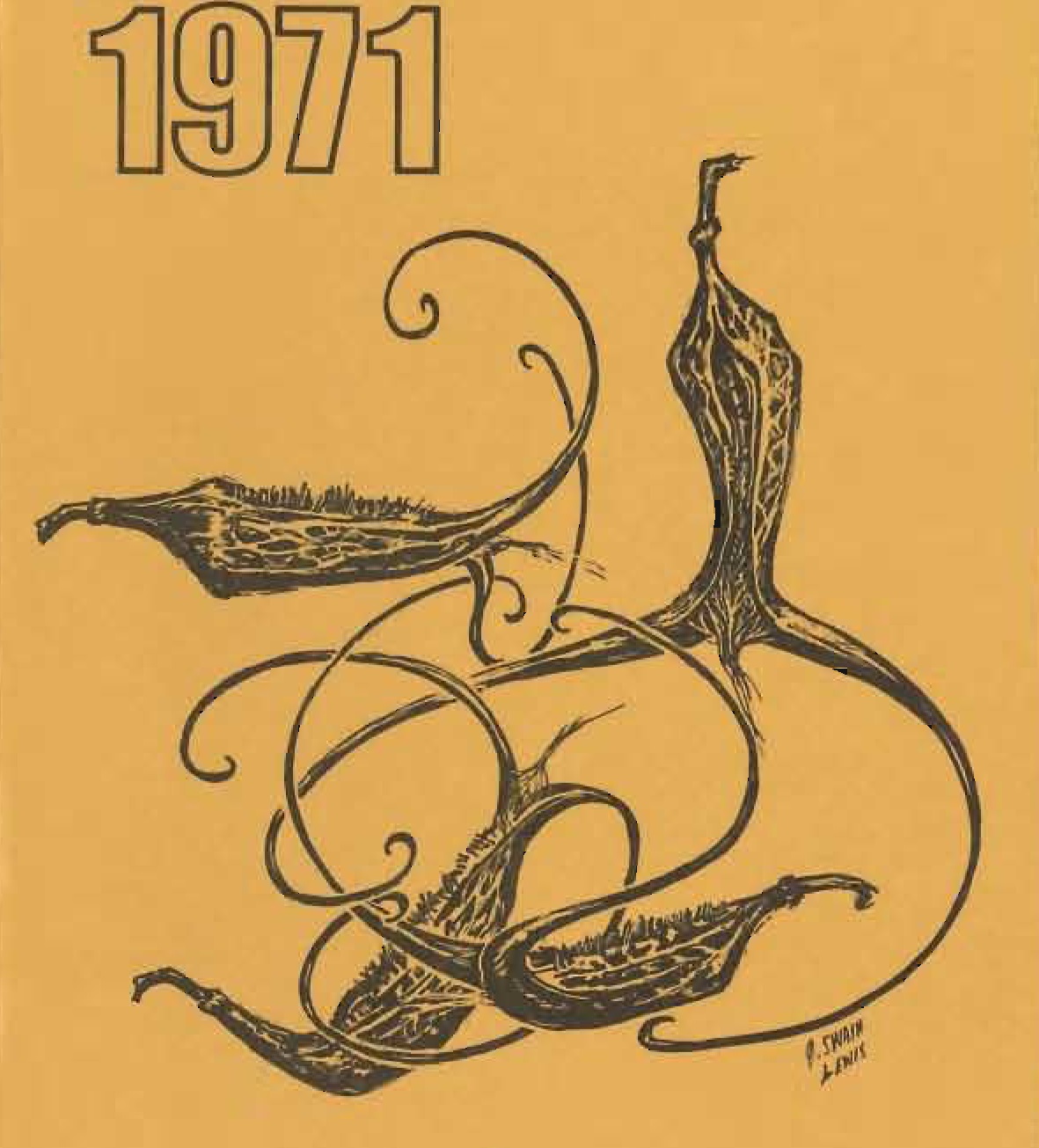|
The Origin of of the Fine Arts Festival
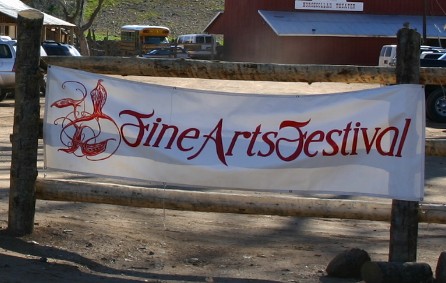
For years, Dot Lewis had attempted to make art a more vital part of the Orme School curriculum,
an effort which was again and again stymied by the Scylla and Charybdis of art programs everywhere:
Money and Academic Accreditation. But let's go back a little earlier, back to an earlier, simpler time,
just a few years after World War II.
Crossing the Cattle Guard
From that first day in 1951, when she drove in her Chevy convertible down the road to the
Ranch, Dot Lewis hoped to make Art a more vital part of the Orme School curriculum. After
all, she was an Artist! But she was also a young Southern woman, with a whiny 3-year-old in
tow, and just one of several young teachers, in her case, not even formally trained as an educator.
True, she was an instructor --- flying and horses --- and at least the "horse" part fit the Orme
program well.
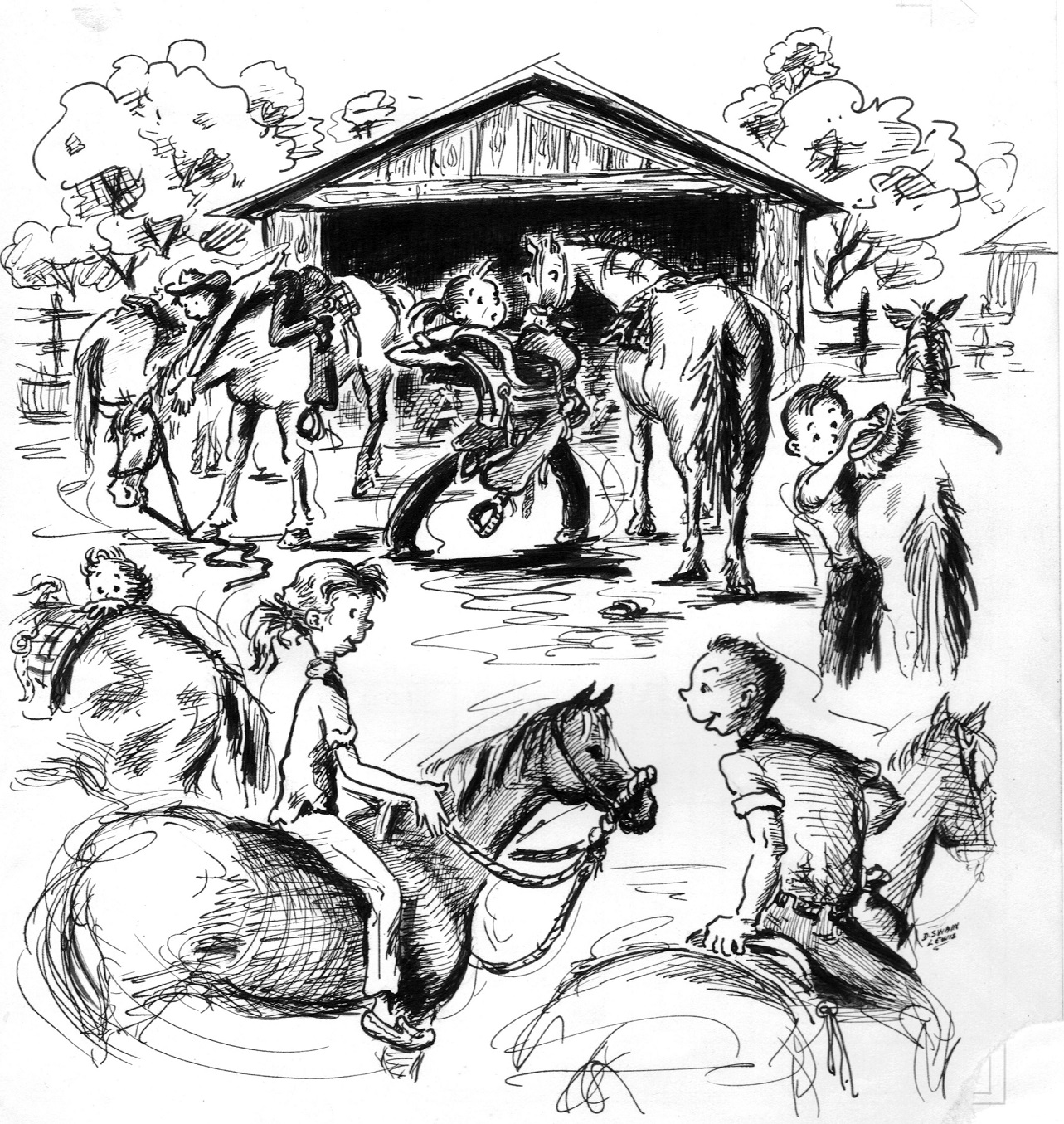
And she had been a good student in college, majoring in zoology. And she had
been a proctor at the prestigious New York Art Students' League. So the Orme
School, at that point directed by Chick, Mort and Charlie Orme took a chance on her, hired her,
and she embarked on her career at Orme, teaching virtually all the classes offered other than
language: all the sciences: physics, biology, chemistry, the various histories: ancient to modern.
She arrived at an institution that was quite a contrast from the central realities of her earlier life ---
her female independence, her art studies. But it provided what she worried was missing for her
son, plenty of good masculine role models, as she sought to reestablish her life after separating
from her husband, a good man, but one whose background in the Old South clashed too mightily
with her need for independence and escape from the old southern traditions. She headed west
and arrived, on the recommendation of a friend, at the Ranch.
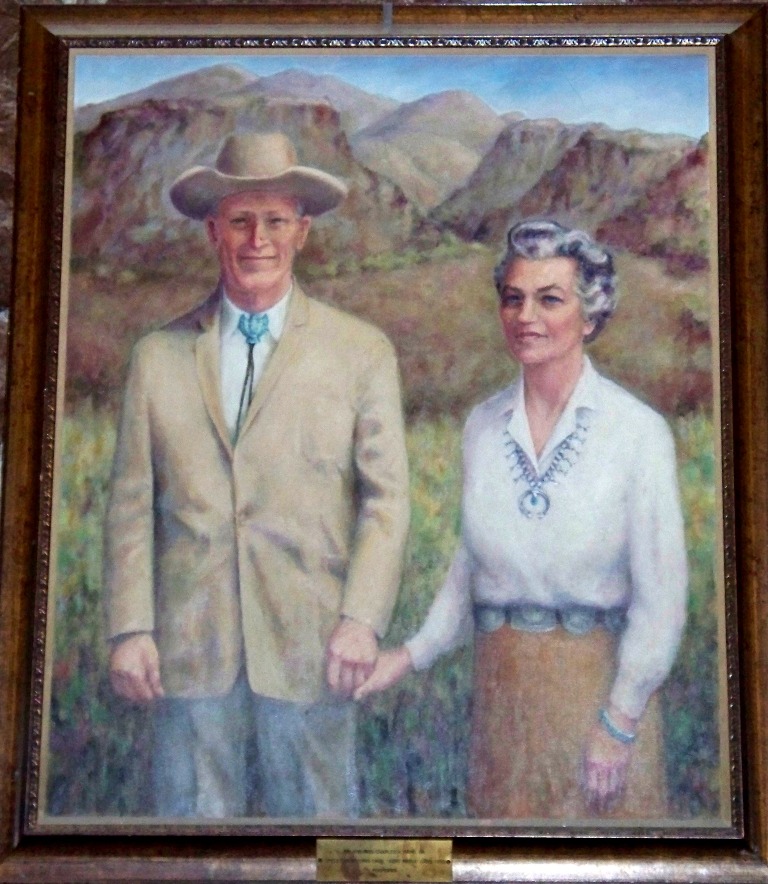
The Orme School, on the Quarter Circle V-Bar Ranch, is an institution founded on a vision of an
earlier day --- when men like Chick Orme tamed the wilderness and women like Aunt Minna
gave unwavering support and moderated the hard work ethic with pieces of culture, music and
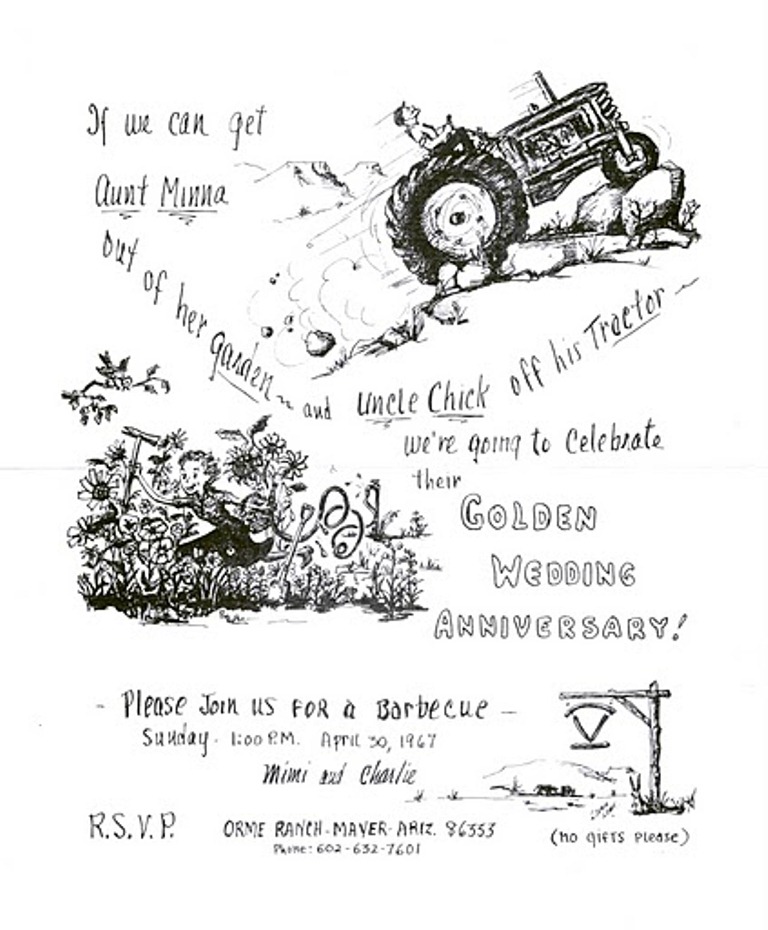 some art, delivered as a respite from the hard necessities of traditional life. In fact, Minna was an amateur astronomer, and became the real
cultural source for much of the Orme community, her contributions being recognized in 1989 by the Arizona Women's Hall of Fame. (link)
some art, delivered as a respite from the hard necessities of traditional life. In fact, Minna was an amateur astronomer, and became the real
cultural source for much of the Orme community, her contributions being recognized in 1989 by the Arizona Women's Hall of Fame. (link)
Strength, Courage,
Hard Work, Persistence, Responsibility --- these were the virtues which were honored. When the
school started, seeking academic instruction for the children of the Ormes, it was the basics
which were the foundation of the curriculum, basics defined in traditional ways. With the death
of Kate, Chick and Minna's daughter, it was the three Orme men who most defined what the
Orme School was meant to become: Chick, Mort and Charlie. The Orme Experience reflected that
reality: tough, hard-working, male.
Dot soon became a part of the school family, not quite fitting the traditional model as a single
woman, but proving rather invaluable --- her graphic art skills were quickly appreciated in the
production of school publications, the school yearbook, and her skills as a horsewoman met the
needs of the Ranch. In addition to her teaching duties: Chemistry, Physics, History, Table Manners,
she kept at her own art, sketching up and down creek, up on the mesa.
But Dot's
background was always somewhat at odds with the traditional setting, which became more somber and
narrowly focused with the sad death of Mort Orme due to a foolish medical error.
Mort, who had an artistic side himself, had helped with the Orme yearbook Hoofprints, fashioning and using the
QCVB cattlebrand to burn into the yearbook cover. His wife Lynn, who artistic leanings found a
natural bonding with Dot, left the ranch. Later on, Mort and Lynn's daughter Lynly returned to the
Fine Arts Festival as a workshop leader, having became a fine artist.
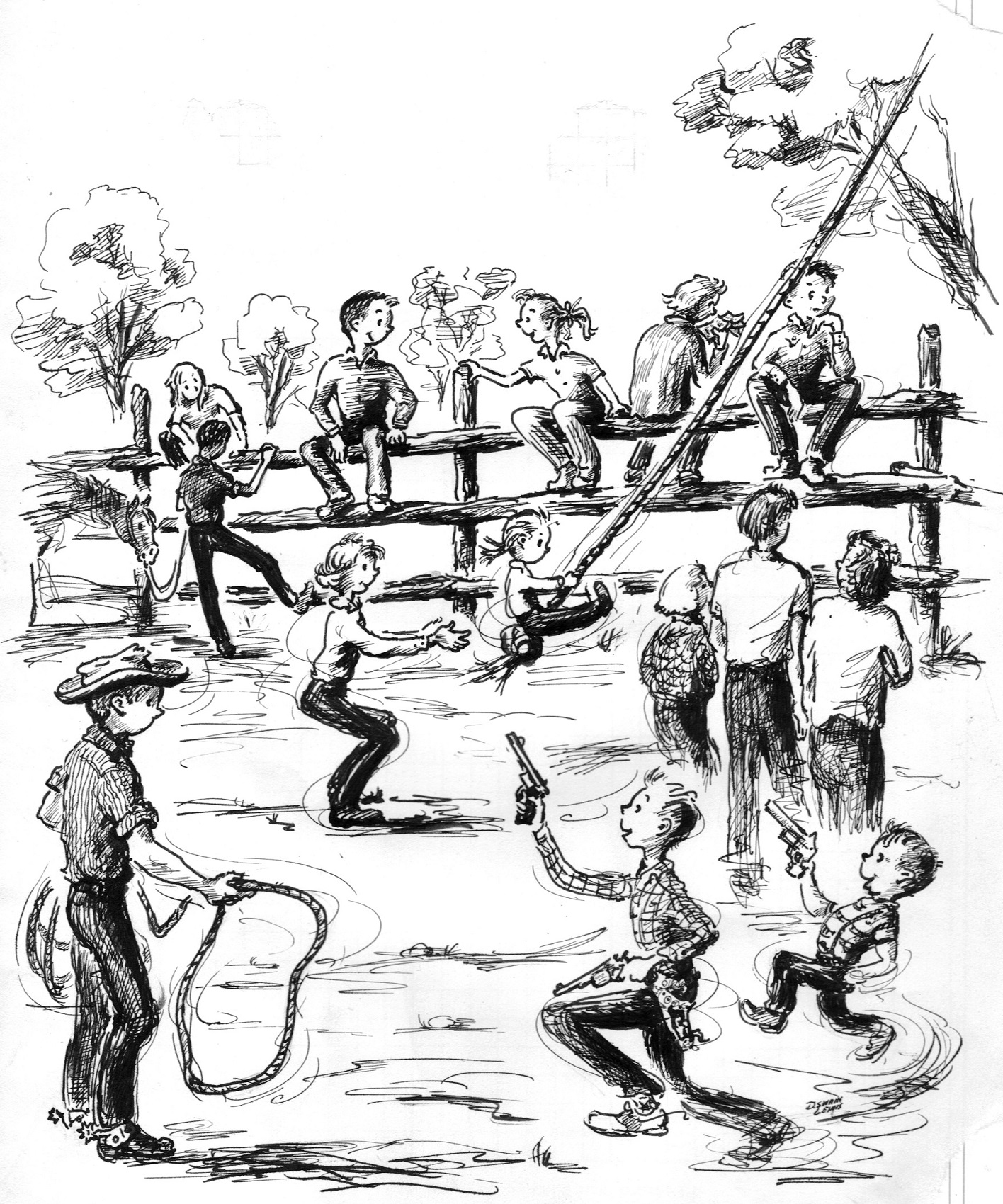
[Top]
The Terrible Twins
After she had gained at least year or two of seniority, Dot sought to introduce art into the
academic curriculum, but was blocked by the standard arguments: Money and Academic
Accreditation. These terrible twins either howled "Destitution!" . . . if cold hard cash was to be
diverted from standard expenditures necessary for secondary school excellence (such
football mouth-guards or rats for the lab), or sadly moaned "No Credit", asserting
the common theory that students always need more instruction in math and science, or in simple English
grammar, but not in the Arts. Consequently, art instruction was seen as
a diversion or focus away from student achievement on standardized tests, their ability to enter
well-known colleges (or any college). More important was to enhance the reputation of the school
as measured by whoever it was that measured these things, including the accreditation of the National Secondary
School Association or the American Society of High School Principals. It was also feared that
artistic frivolity would dampen, most importantly, the inclination of concerned parents to seek the
enrollment of their tender children in a school on a working cattle ranch.
For these reasons, it was commonly believed that the consequence of setting more
than a little time in the curriculum for Art, or spending actual money on Art, would
naturally result in either a slow or a quick death of the institution.
The Orme School, founded in 1929, carefully and slowly growing since then, was ponderously determined
to make it into and through the 60's.
A Different Approach
In the face of such serious and unrelenting opposition, Dot Lewis did what any artist does quite
naturally, . . . try another way. Then, after failure or even a setback, try something else.
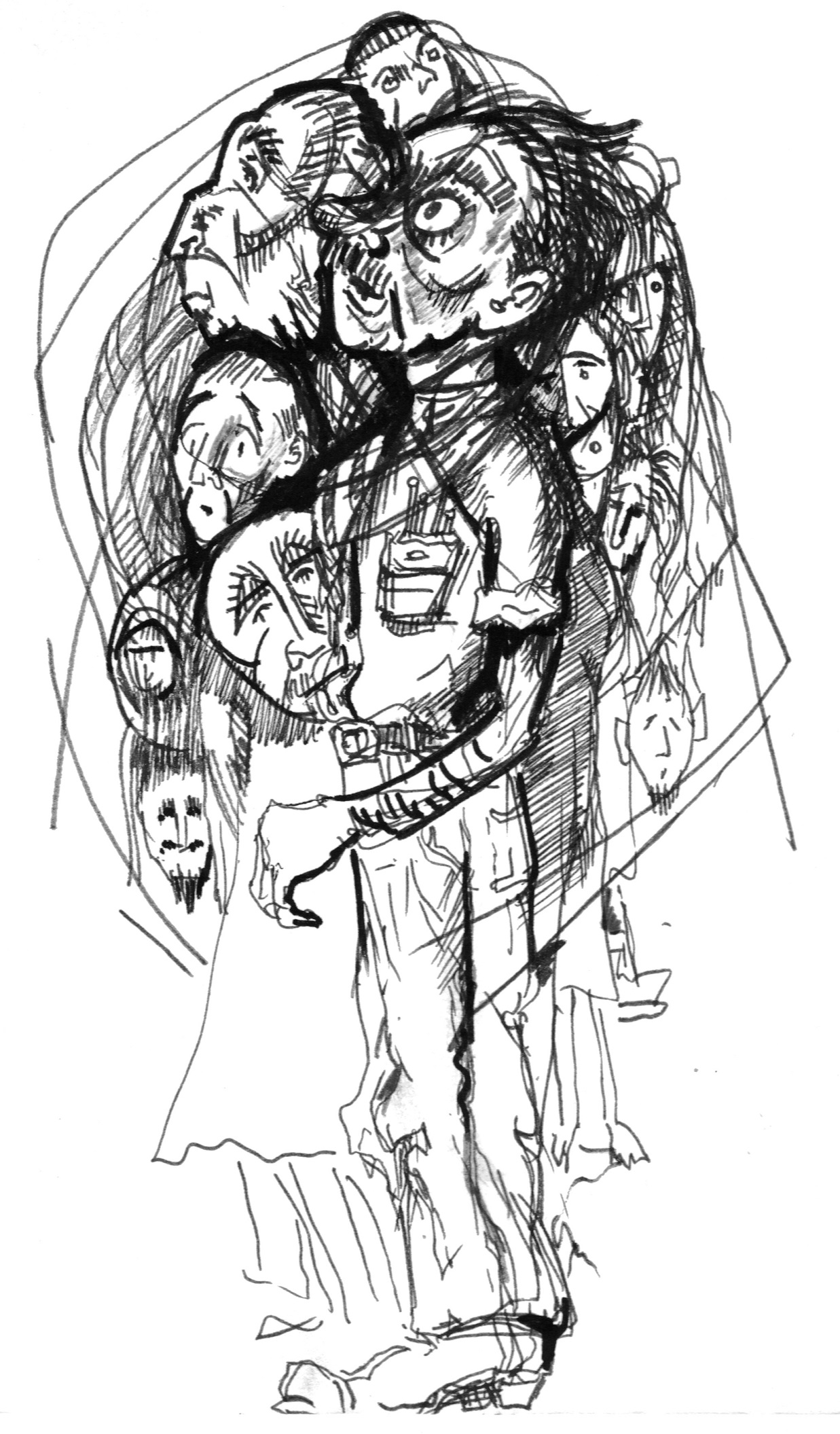
This approach is difficult for a pure scientist. If you do not have a working theory of how to
obtain a scientific discovery, or more importantly, the tools to give you working results, progress
does not occur. For the artist, although usually very well versed in such "scientific" things as
color theory, cadence, or anatomy, the lack of a defined concept or a measurable pathway poses
no perceived barrier --- you simply use a feather, or try your thumb, or something totally
unexpected, perhaps a purple as a shadow in the midst of a pure white body.
And if you can't teach Art, because it is not "academic", why not consider the History of Art? Is
not THAT a proper academic subject? Of course "Art History" was an odd piece of academia in 1950s US ---
not normally tested as a subject on standardized tests, but having the odd habit of
suddenly appearing . . . a question using the word "Picasso" . . . or some reference to the Sistine
Chapel, hard to argue that a knowledge of these things could not help you somewhere down the
line. And Art History was indeed "History", a good traditional theory of knowledge, testable
with multiple choice quizzes, and capable of a measurably defensible grading system,
understandable by the local banker or academic accountant. And it is very hard to argue that
some of these paintings or statues were not worth a lot of money or generated money for
someone somehow connected thereto. And though Andy Warhol might be detested for his lack of
perceived craft, one could not argue that he made money. So, though a little awkward and unsettled,
art history became a part of "the Orme experience".
And do, after years of teaching biology, physics, baseball, history, roping, English, the football huddle,
mathematics, the Judeo-Christian heritage around campfires, horsemanship, chemistry, the Orme School
offered Art History. This became an "academic requirement" and graduates of Orme suddenly
became capable of recognizing a painting such as Guernica or an artist such as Vermeer or
Jackson Pollock. Art had made its beachhead on the dry dusty (but irrigated) soil of the Orme Ranch.
Allies and Co-Conspirators
As a woman, Dot Lewis usually asked her good friend and fellow teacher Jim Wilbanks to
propose more ambitious items in faculty meetings or other opportunities where serious
administrative consideration was desired. While certainly overt sexism or racism could not have
been said to exist in the Orme administration or Board of Trustees, somehow things just seemed
to work better that way. And Jim, a fellow "liberal" in an environment that sought almost desperately the
comfort of conservative philosophy: heritage, tradition, standards, religion, knew the game well.
He was a mathematics teacher who loved mathematics and appreciated the underlying theory, the
"art" of mathematics, in a world that learned math by rote. Few students would ever share his
true appreciation of the beauty of math, and so his instructional efforts had to use indirection as
well. His willingness to assist Dot move the administration toward aesthetics was natural.
And there were other co-conspirators, such persons as Henry Brooks, the Latin teacher, and thereafter,
choirmaster and music teacher,
whose efforts to develop the choir could scarcely be criticized by an institution
whose most prominent architectural feature was the Mort Vrang Orme Chapel, and instruction on
the Judeo-Christian heritage a fundamental part of the school philosophy.
The Orme Judeo-Christian Heritage
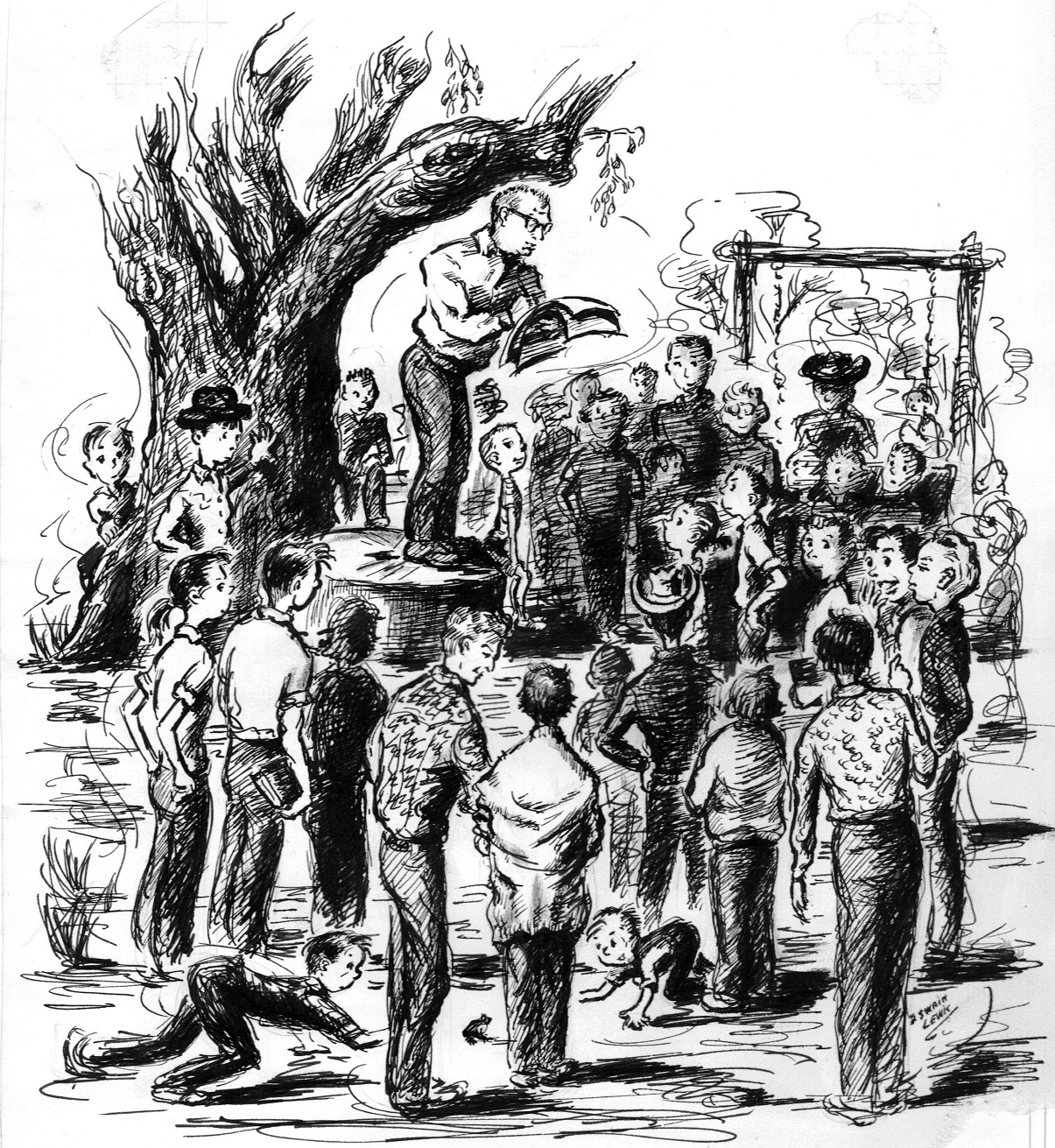 Orme, though not a
religious school in any way, has always felt itself grounded in the notion of "Tradition", if not
directly religious, at least wrapped in philosophy and concepts that mirror the teachings of the
great Religions. To Orme's credit, ministers of many different religious traditions were routinely
brought to the school for the mandatory Sunday services: Rabbi Plotkin, Reverand Urbano, other
guest ministers that would share with the Orme students. And choirmaster Henry would work
long hours to bring diverse music to the program, Mendelson when the rabbi visited, Baptist,
Methodist, Gospel tunes during the Christian services.
Orme, though not a
religious school in any way, has always felt itself grounded in the notion of "Tradition", if not
directly religious, at least wrapped in philosophy and concepts that mirror the teachings of the
great Religions. To Orme's credit, ministers of many different religious traditions were routinely
brought to the school for the mandatory Sunday services: Rabbi Plotkin, Reverand Urbano, other
guest ministers that would share with the Orme students. And choirmaster Henry would work
long hours to bring diverse music to the program, Mendelson when the rabbi visited, Baptist,
Methodist, Gospel tunes during the Christian services.
The history of Religion has always been entwined with the history of Art, religious leaders have
almost universally recognized the value of art --- the ability of Art to assist mere mortals to
understand or at least accept concepts of transcendence. Music has always been a fundamental
part of Religion, of keeping people from sleeping in church, raising their communal
consciousness, providing the exhilaration of sound coupled with physical effort, perhaps hard to
really understand, but undeniably effective in its results.
While the leader of the Orme School,
Charlie Orme (headmaster from 1945 to 1987) could never be equated with Pope Pius in terms of his patronage of the arts,
but his broad education and travel profoundly appreciated the forces that led the great religions of the
world to devote so much of their resources to the creation of buildings and sculptures and
paintings, as well as the source of so much music and tradition. If possible, Charlie would allow
the development of art into the curriculum. Opposition was not based on disdain for the value of
art or music, but a lack of confidence that "academic standards" would permit funds to be so
obligated. Of course, he did view art education and indeed the Fine Arts Festival as a
"frill" that was not a reason parents would send their children to the Orme School, and in his
book about the building of the school, written when he was in the last years of his life, he
attributed a drop in the enrollment to the lack of value of the Festival.
Yet even before the Fine Arts Festival, outstanding artists were brought to the school for special programs. The great
singer Beverly Sills gave a mini-concert for freshly scrubbed young cowboys and cowgirls who
fidgeted somewhat uncomfortably in the Horsecollar Theater.
The Importance of Parents
Much of the improving climate for Art came from the parents of the students, such as Sandra
Kempner, whose son attended Orme and whose relationship with the great Arizona artist Philip
Curtis led to Dot's ongoing communication with him, and his loan of his paintings for the Fine
Arts Exhibit, an act which insured the notoriety of the show as well as the eager participation of
other fine artists. Other parents and Trustees, especially such as Betty Phillips and Sandra
Greene, who had daughters as students at the school, provided the chorus that approved when the notion
of bringing Art to the cattle ranch was proposed.
And every summer, since the year after Dot Lewis had arrived at the Orme School, she packed up
her son and car, and headed for California to explore life beyond the Orme fences and cattle
guards, seeking further instruction in the areas that she loved, up in the mountains of Idyllwild
and at Scripps College in Claremont, where she obtained her Masters in Art during a two-year
absence from Orme in 1955 and 56. When she returned to the Orme School, Dot was loaded
with the latest information from art educators and wrote articles for publications* reporting
the linkages that were beginning to be re-recognized, between music, art, creativity, and
academic excellence. * ("The Vital Years" - article written in early 60s)
Actual Art Instruction
Ultimately --- after all, it was the Sixties --- Art became more than just Art Appreciation or a short
babysitter class. Dot had served years now on the Disciplinary Committee, directing the punishment of the many
 teenage malefactors of the School, often assigning something as cruel as assisting the
construction of one of the School mosaics to some young wrongdoer, or in another case, having
to sit as a model while Dot did her portrait. Student crime on the wane, the School owed Dot
Lewis a debt of gratitude, and, as the Flower Generation began to flower, the Orme School began
to allow direct instruction in art. Finally, in Dot's opinion, the school allowed the important 2-
hour class period, a necessity to permit students to develop a meaningful facility with the tools
and instruments of Art, a pre-condition for the development of any real skill, and possible life-
long involvement with that which we call "Art".
teenage malefactors of the School, often assigning something as cruel as assisting the
construction of one of the School mosaics to some young wrongdoer, or in another case, having
to sit as a model while Dot did her portrait. Student crime on the wane, the School owed Dot
Lewis a debt of gratitude, and, as the Flower Generation began to flower, the Orme School began
to allow direct instruction in art. Finally, in Dot's opinion, the school allowed the important 2-
hour class period, a necessity to permit students to develop a meaningful facility with the tools
and instruments of Art, a pre-condition for the development of any real skill, and possible life-
long involvement with that which we call "Art".
 Dot also continued her own art as she performed her teacher duties, painting the Riderless Horse
after the assassination of John F. Kennedy, and continuing her exploration of small sculpture and
rock drawings, developing friends in the art community, as she led students on special trips to art
museums. These programs did NOT require extra academic funding but fit in with the expansive
view of education that Orme, as through its caravans and other expeditionary efforts,
found compatible with formal class-work. Dot exhibited from time to time with some of her
fellow artists, and continued to lobby the Orme administration for greater and greater access to
the arts. With such other teachers as William "Buck" Hart, whose personal dramatic tendencies
could not possibly stop at the classroom door, Orme began to develop its artistic side step by
step. When a local gallery owner sent invitations to all the high schools in Northern Arizona to
participate in a special show for high school art students, Orme was one of the few who
responded. What was to be a show of Arizona high school students became largely a show of
Orme students.
Dot also continued her own art as she performed her teacher duties, painting the Riderless Horse
after the assassination of John F. Kennedy, and continuing her exploration of small sculpture and
rock drawings, developing friends in the art community, as she led students on special trips to art
museums. These programs did NOT require extra academic funding but fit in with the expansive
view of education that Orme, as through its caravans and other expeditionary efforts,
found compatible with formal class-work. Dot exhibited from time to time with some of her
fellow artists, and continued to lobby the Orme administration for greater and greater access to
the arts. With such other teachers as William "Buck" Hart, whose personal dramatic tendencies
could not possibly stop at the classroom door, Orme began to develop its artistic side step by
step. When a local gallery owner sent invitations to all the high schools in Northern Arizona to
participate in a special show for high school art students, Orme was one of the few who
responded. What was to be a show of Arizona high school students became largely a show of
Orme students.
ISOMATA
Back up in the summer mountains of California, Dot had met up with an old friend, Harry
Sternberg, an artist who had been the Director of the New York Art Students' League when she
studied there back in the 1930's and 40's. Harry taught painting at the Idyllwild School of Music
and the Arts (ISOMATA), a summer program based on the belief that the fine arts complemented
each other, that dancers and painters had much in common and could gain from musicians and
fine craftsmen. It was also based on a conviction that a summer program, based on Music and the
Arts, should offer a place for each member of the family, from the bread-winning professional, to
the hard-working spouse, and to each variation of children, ranging from mere toddlers through
chaotic junior high youth to the rigidity of late-teenager angst right on up to recently thought-and-
class liberated college students.
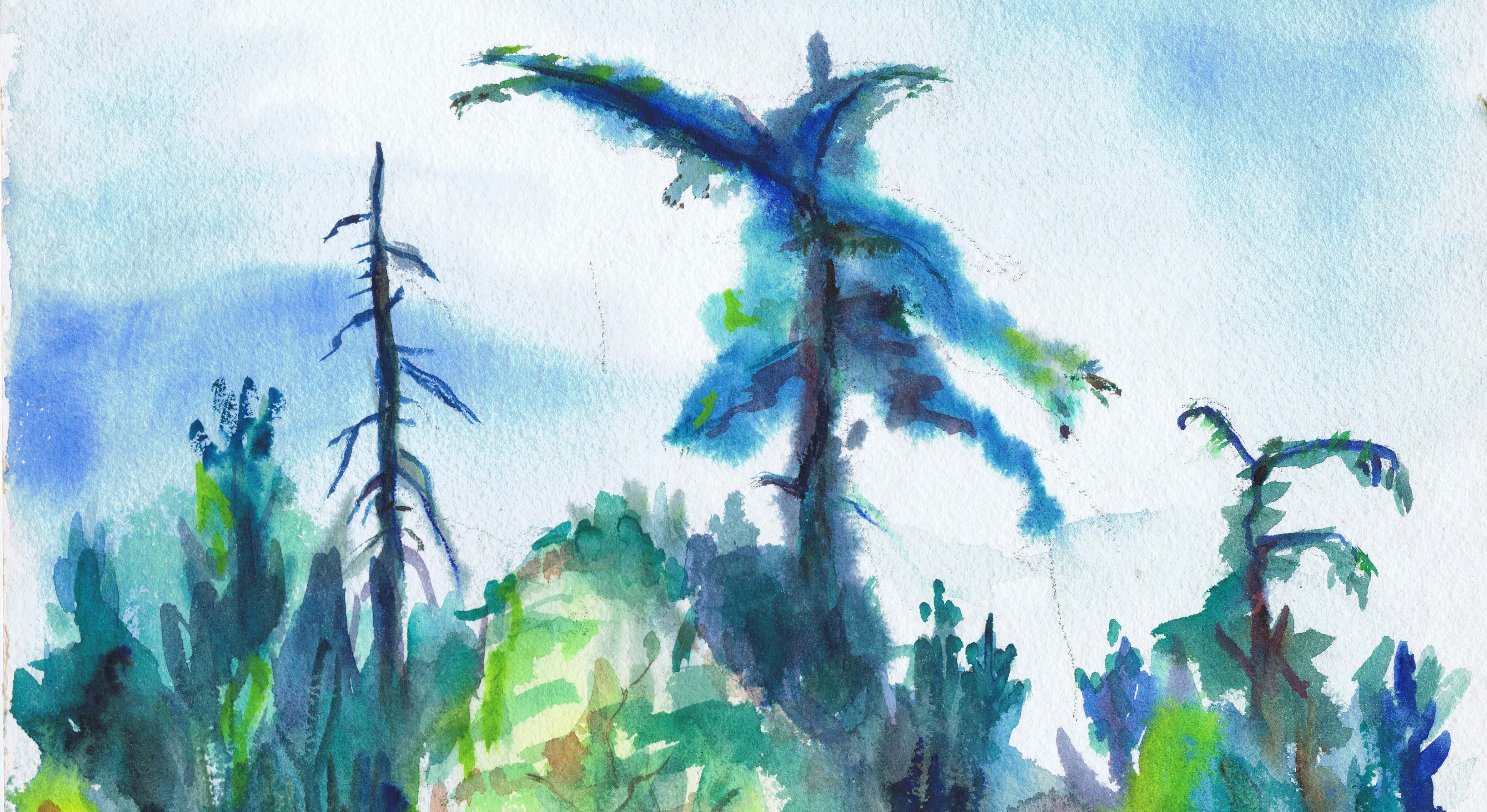
In the evening programs, members of the ISOMATA
community would view presentations of art or music from any of the diverse classes, a puppet
show by one of the foremost puppeteers of Los Angeles, a dancer from Africa, or a full
symphony featuring a guest artist who had recently performed at the Hollywood Bowl or back east. The
atmosphere of ISOMATA in the 60s affected all who were fortunate to be there, the teachers,
the students, the counselors, the children, all of whom left imbued with a sense that art and music
were universal elements that enabled people to grow in all ways.
For many years, from the 50's to the 70's, Dot participated each summer in the ISOMATA community, taking a
sculpture class from Lora Steere, then teaching various classes in the graphic arts, including
print-making, enamelling, and watching her 7 year old son grow up enjoying the benefits of summer program,
with music, dance and art, and learning theatre in the junior high program.
ISOMATA continues in modified form today, and has expanded to be a year-round arts academy
(www.idyllwildarts.org), one of three in the country to
combine full art instruction into a sustainable secondary school program, producing graduates who find
success in all the arts.
The DEAD of WINTER . . . oh Why! Why? Why!
At Orme, a self-contained community back then, the biggest change of pace occurred at vacation
time. In a single crowded day, virtually all the students, and many of the teachers and staff,
would disappear, leaving the self-sufficient confines of the Quarter Circle V-Bar Ranch, and
return to other homes, back to urban and family settings usually quite different from the wide
open spaces. The ranch would abruptly stop and become quiet.
Instantly, the normalcy of a
200+ community, all working together, serving all aspects of communal living and educating in
the Arizona desert, transformed itself back to a time when only a few small families of Indians or
settlers gazed on the beauties of Big and Little Mesa . . . . , or listened to the coyotes yell at the moon.
This was true of the Thanksgiving short break, Christmas, Spring vacation, and the big one:
Summer. And the return was equally transforming, from the quiet to the re-populated bustle of
the community in a few short hours as all returned.
 But one break always ended with a almost automatic sense of gloom --- the cold, the dreary dark
days, the seeming lack of any prospect of happier days --- the Christmas or winter break at
Orme was different.
But one break always ended with a almost automatic sense of gloom --- the cold, the dreary dark
days, the seeming lack of any prospect of happier days --- the Christmas or winter break at
Orme was different.
Upon returning, the students and staff felt the elation of the holiday spirit
crushed by the somberness of mid-winter and the quietness deeper and more inescapable. It was
a troubling time for school administrators and teachers --- many commented on the difficulty of
getting back to the business of high school after the relative freedom and joy of vacation, when
students returned to the isolation of life on a cattle ranch, away from old friends, urban stores,
city-life, and family.
From time to time, Dot visited the nearby Verde Valley School, another private college
preparatory high school, located in the beautiful Arizona countryside about an hour and a bit
north of Ranch, on the edge of Sedona, and with whom Orme students had a friendly rivalry.
She discussed with Colonel Fisher their programs, much more oriented to the Arts --- she
encountered a student who was working on an independent study project, for a whole week,
working on her own in practically any area, music, art, a project self-directed and encouraging
the broader goals of education: finding something in life you are interested in. This was a
method the school used to develop the personal interest its students in their own schooling.
Regular instruction was suspended, but personal instruction blossomed.

At Orme, the third week after Christmas was the real downer. Something needed to be done --- all the
teachers, trying to regain the focus of the students on the class plan, all the administrators
juggling the small problems that would emerge at that time of year, felt the need for something
bring back a sense of hope or attention or any enthusiasm. Dot sensed an opportunity to make a
piece of Art --- to take a discarded piece of junk, and transform it into a statement of real beauty,
personal expression and exploration. The piece of Art was to remind everyone of the real Basics
of Academia: Music, Dance and Art --- the source of all other academia, what let Man transform
himself from a hairless ape into a creature that could communicate with others of its sort, to
transform itself with thought, various forms of expression and communication.
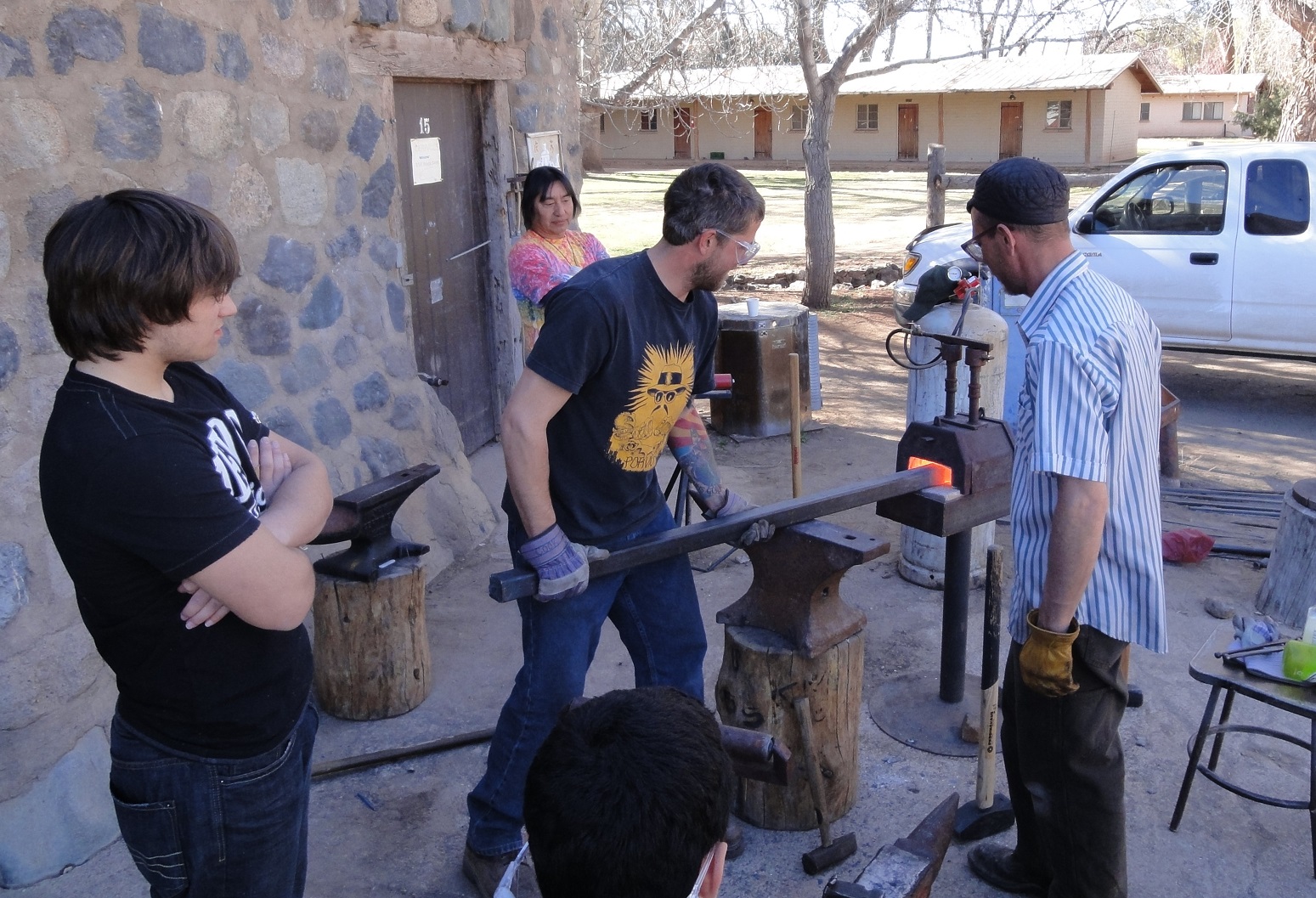
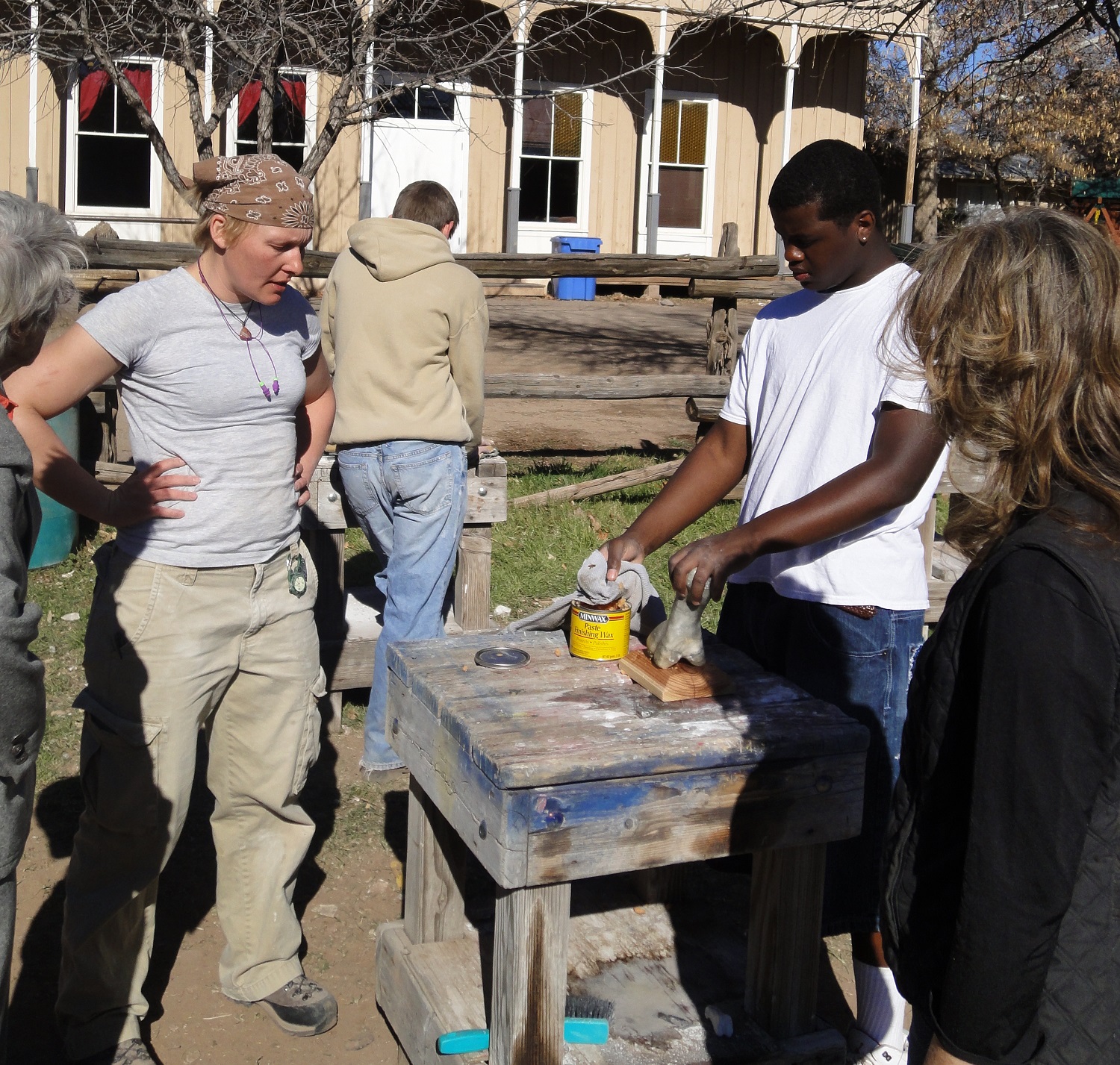
 This fundamental belief seemed to coincide with the need to restart the school process ---
students and teachers needed to remember why they were embarked on the academic enterprise
in the first place. Learning and teaching is fundamentally communication between two or more
individuals --- communication is necessarily expression on the part of one, and observation on the
part of the other. IF Art is, at its most basic form, self-expression, then what the art teacher does
is show one how to see what is expressed.
This fundamental belief seemed to coincide with the need to restart the school process ---
students and teachers needed to remember why they were embarked on the academic enterprise
in the first place. Learning and teaching is fundamentally communication between two or more
individuals --- communication is necessarily expression on the part of one, and observation on the
part of the other. IF Art is, at its most basic form, self-expression, then what the art teacher does
is show one how to see what is expressed.
And so, by remembering that Music taught us how to
count, that Dance taught us how to catch the eye of and impress each other, and that the graphic
arts taught us how to preserve our desire to communicate, teachers and students would remember
why proper English, mathematical symbols, the stories told in History, and the technical skills of
chemistry came into being --- the product of our need to communicate, to create, to remember, to
improve our lives through our individual endeavors.

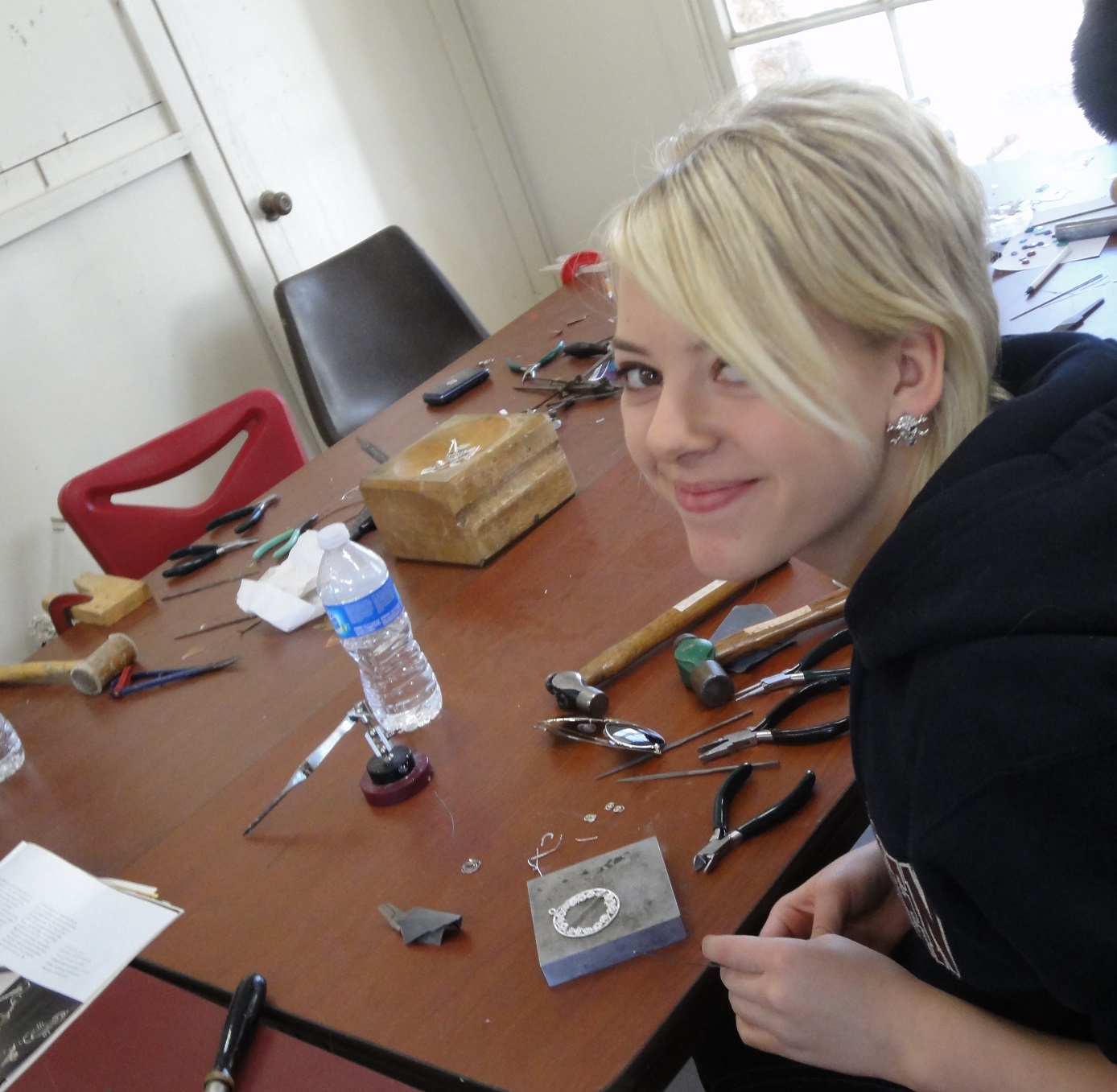
Art would merge with the Academic Plan ---
the Orme School would restart itself with a reminder of the original source of all schooling. The
basic artistic impulse of Man would be tapped to get students and teachers to once again
communicate with each other. To express themselves and to observe. This is the basic artistic
impulse --- to make a pleasing noise, to costume oneself, to create an object or design that
conveyed something to someone else, to discern the beauty in ourselves and in each other. To
celebrate our mutual interest.
The Start
Dot executed her plan carefully. The first week of February was the time to start.
It was critical to get everyone in the community involved. Just as every person is different,
each person has different preconceptions, preferences, skills and disabilities --- to unify the
community behind this total disruption of the school schedule, all had to find something
appealing. So ten different workshops were planned, Dot believing this to be a minimum to
accommodate the diversity of the community and also establish a sense of the broad possibilities
of Art, accessible and necessary for all.
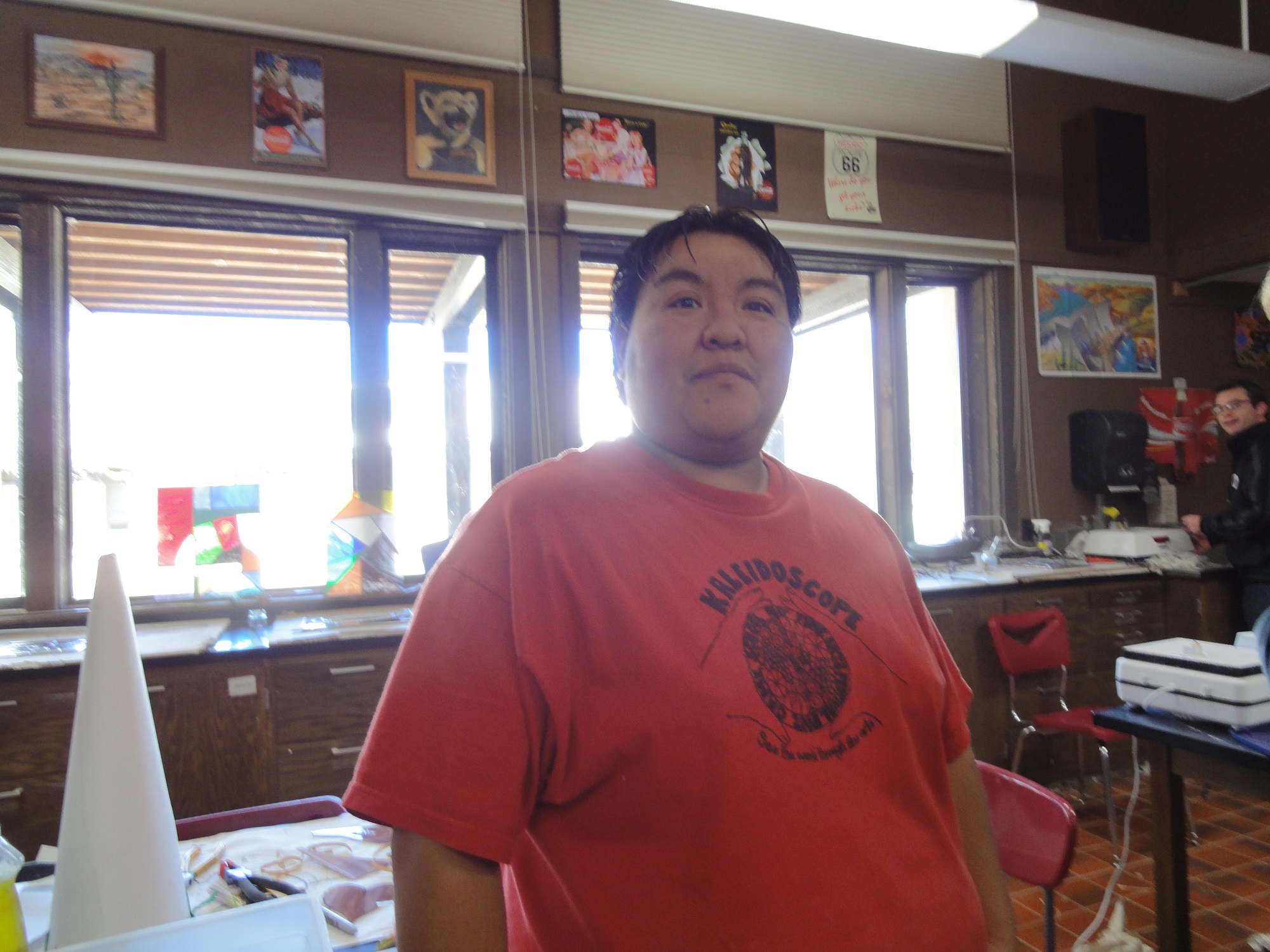
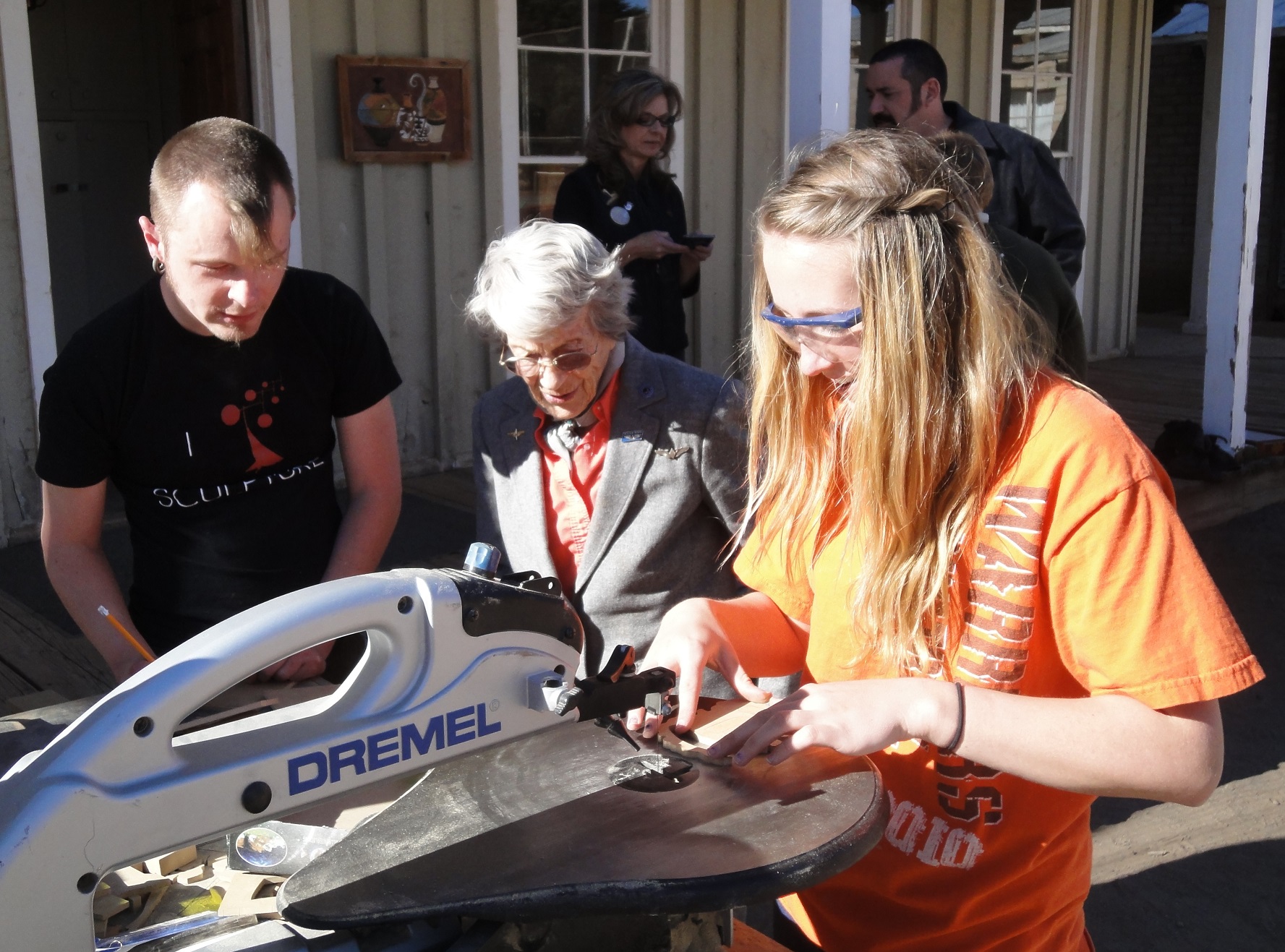
And it was critical to find the right artists --- enthusiasm
for their skill and desire to share was critical. Compensation could not be the motive --- the
school would only offer an "honorarium" to perhaps offset a bit of the lost time that the artist
would be sacrificing for the cause. Because this was to be a regeneration for the Artists as well ---
a reminder of what sparked their careers, why Art was meaningful. As Dot knew from her
experiences at the New York Art Students League and at ISOMATA, artists enjoy the company
of other artists, and in trying to reach young people, felt renewed in their own source of
inspiration. She depended on her close friends and mentors such as Harry Sternberg who
immediately saw the goal and beauty of the idea and enthusiastically supported her efforts. She
spent a lot of time on the phone, and identifying those local artists that others knew, that had an
inclination to participate. The selection of each artist could lead to another --- many would come
because of the other people invited.
 The other faculty members needed to be invested in the project, and each would be assigned to
one of the workshops to share the experience, and reestablish the sense of common purpose that
teacher and student must ideally share. And the week would be capped with an Exhibit that
would show the ultimate possibilities of Art --- professional and of the highest quality. Here Dot
drew upon her many artist friends, driving many hours to personally arrange the safe
transportation and generous loan of the best art available, to be displayed properly and
professionally at the Orme School so that the students, the teachers and visitors would know
without a doubt the power, the importance, and the look of professional Art.
The other faculty members needed to be invested in the project, and each would be assigned to
one of the workshops to share the experience, and reestablish the sense of common purpose that
teacher and student must ideally share. And the week would be capped with an Exhibit that
would show the ultimate possibilities of Art --- professional and of the highest quality. Here Dot
drew upon her many artist friends, driving many hours to personally arrange the safe
transportation and generous loan of the best art available, to be displayed properly and
professionally at the Orme School so that the students, the teachers and visitors would know
without a doubt the power, the importance, and the look of professional Art.
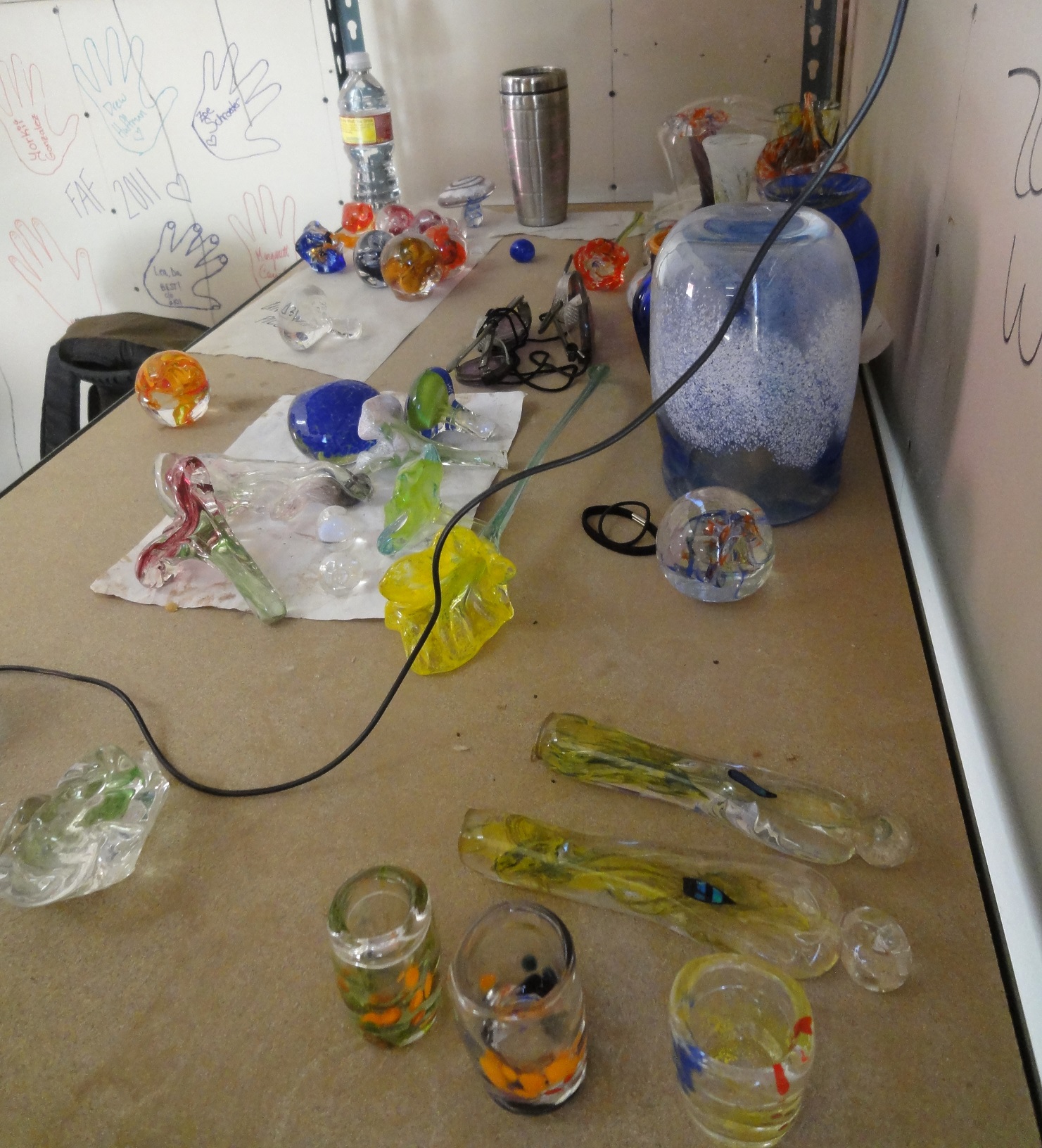
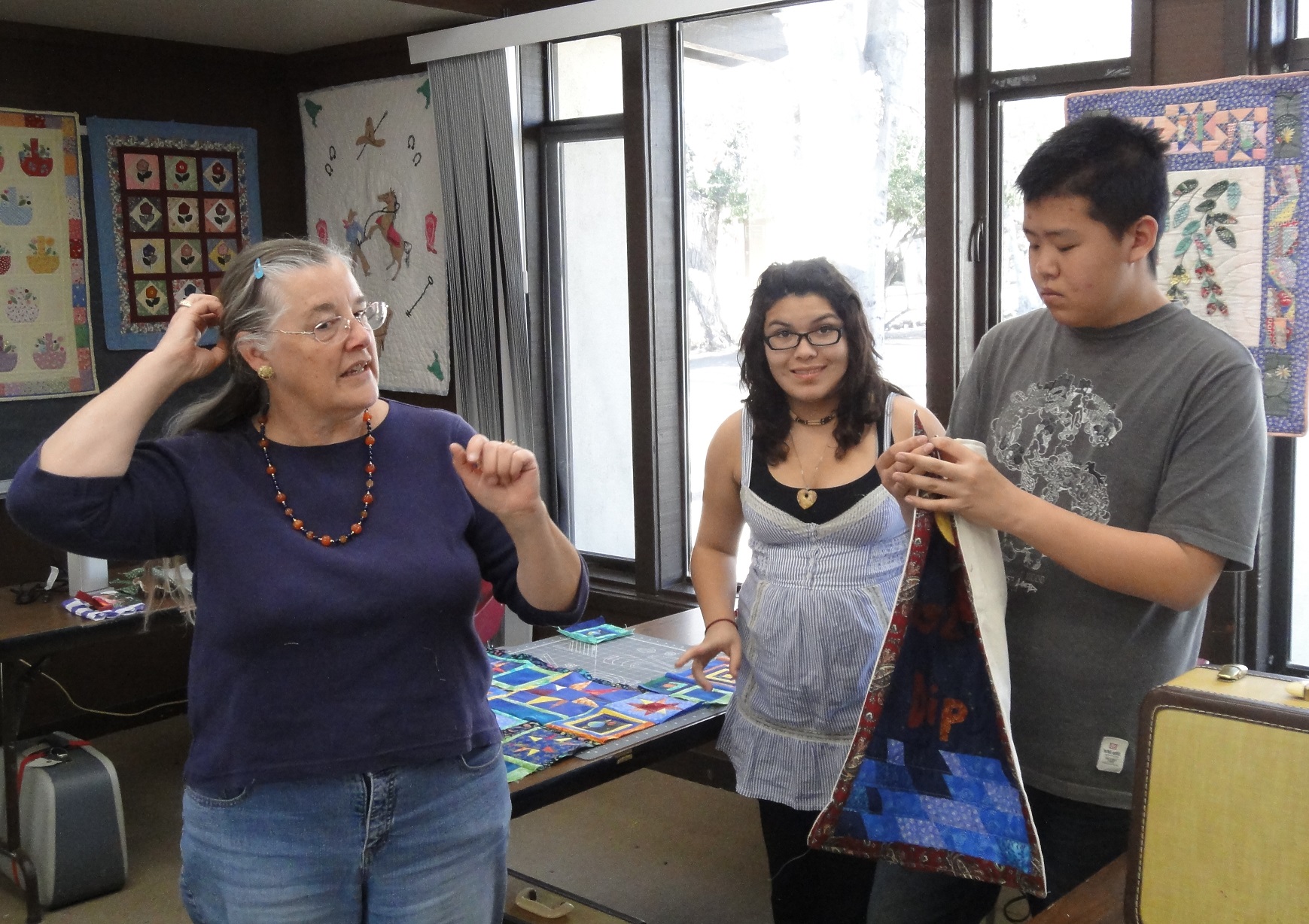
The initial budget, twisted out of the clutching fingers of the business office, was $1,100 to cover
all the expenses that the endeavor would entail. The honorariums were either nothing or very
little, much of the supplies were scavenged or purchased very carefully. To date, many of the
artists who come to the festival, like art teachers everywhere, bring supplies carefully obtained at
less than normal cost, the reality of professional artists who have to measure dollars carefully in
the creation of art. This frugality seems the secondary lesson of the artistic impulse, the ability to
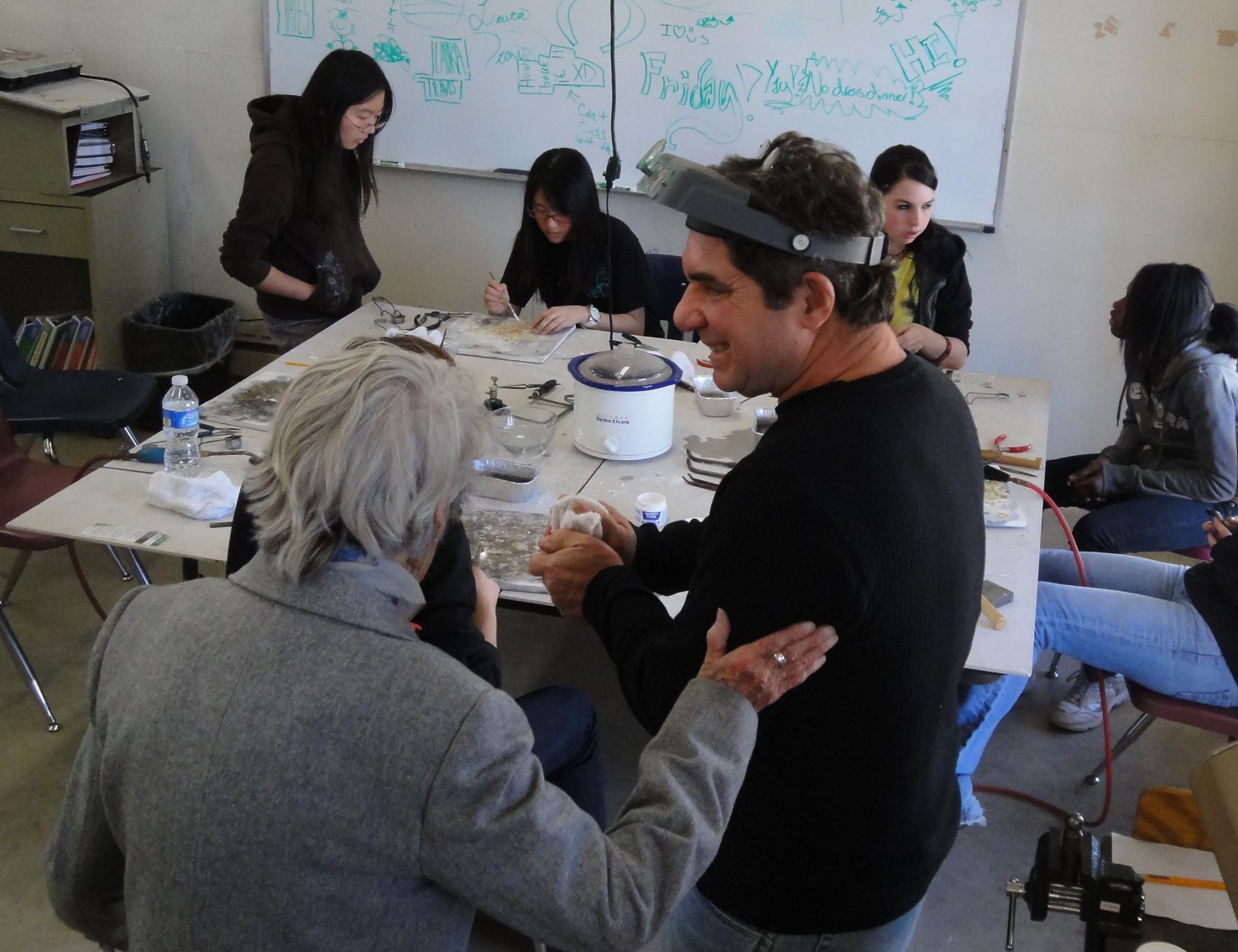 take what is available, and transform it beyond its initial form. Art is the expression of the
Possible, surprising, transcendental, an endeavor that does share with Politics acknowledgment
of its limits, but then inflates all accomplishment with a sense of universal meaning, and the
fullest achievement of human endeavor. While the budget today is much bigger, the same
financial creativity renders the week an exercise in economy, invention, audacity over quantity
and traditional power. Such is the lesson of Art.
take what is available, and transform it beyond its initial form. Art is the expression of the
Possible, surprising, transcendental, an endeavor that does share with Politics acknowledgment
of its limits, but then inflates all accomplishment with a sense of universal meaning, and the
fullest achievement of human endeavor. While the budget today is much bigger, the same
financial creativity renders the week an exercise in economy, invention, audacity over quantity
and traditional power. Such is the lesson of Art.
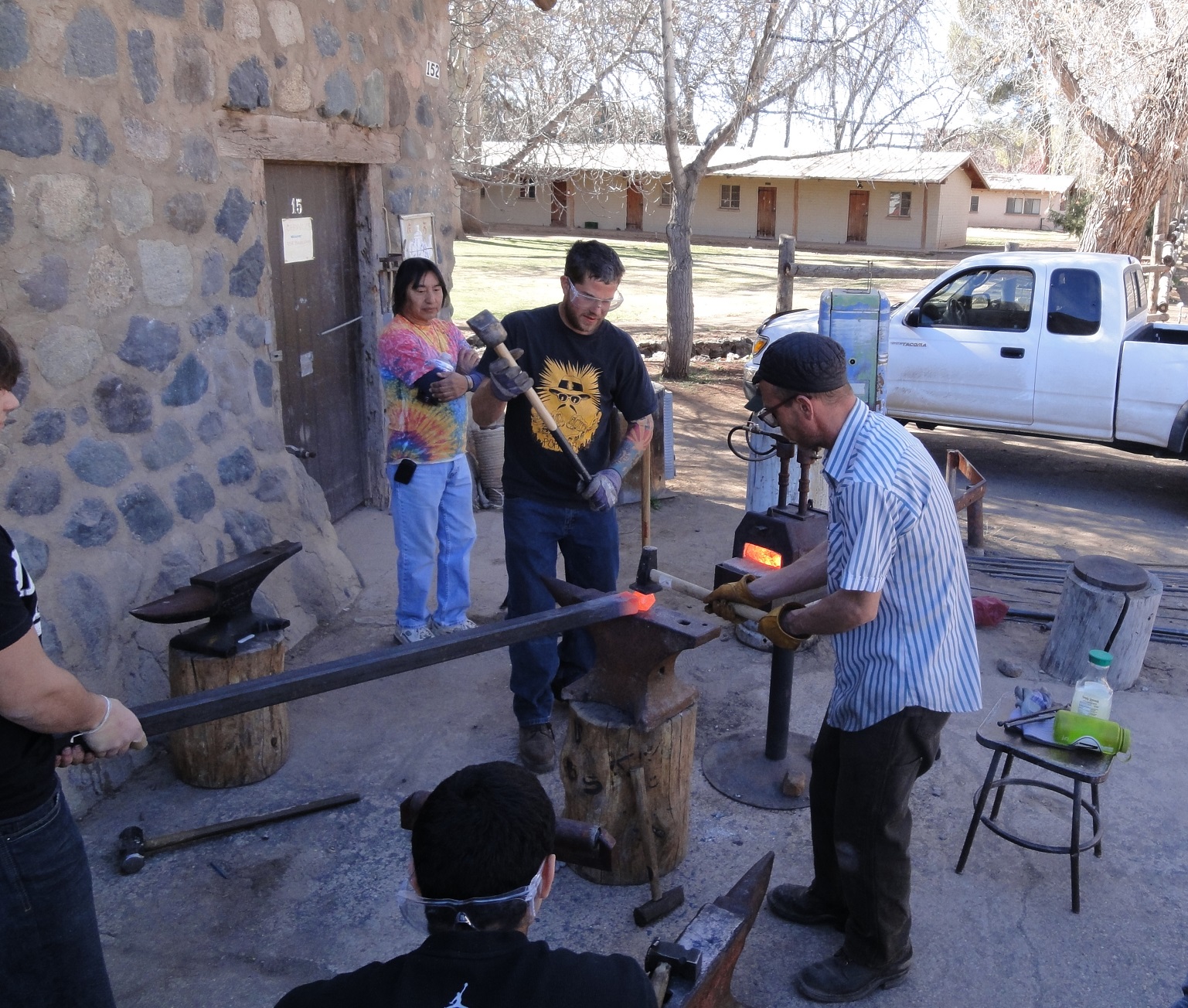
The artists who come are mostly driven by a special feeling that the Festival is an opportunity as
much as an honor . . . to be asked to participate in a unique event that can return to the artist as
much as the artist gives to the students. Something about remembering the origins of one's
initial creative impulses provides a renewal of one's creative energies. This was the happy
coincidence that merged the needs of winter-bound students and artists into a mutually beneficial
collaboration, refreshing both at a time of the year when depression holds easy sway.
And so it began.
The Basic Principles
Dot developed a set of rules she set for herself in the development of the Fine Arts Festival, to
match her vision and the underlying purpose.
One: Everyone in the Orme community would participate, it was NOT optional, and not dependent
on prior skill or exposure to the tools of Art.
Two: The artists must be of the highest caliber, top people, the best that could be found, professionals.
After all, the point is to show that ART is a profession, a necessity of civilization, not a therapy,
or entertainment, but a part of the solution, the quest, the meaning of life.
Three: The artists needed time to meet with each other without the students --- the social
interaction between the artists was critical to the sense of artistic community that then extended
to the students, and the full realization that Art is a fundamental, not optional, part of Life.
Four: The Festival would be ended with a demonstration of the results of the week's work, a
fully professional Exhibit which would demonstrate the reality of success in the Arts, and
programs or exhibits that would show the whole community what each workshop had worked on. (Over time, the Festival
Art Gallery Exhibit also included the Orme Fine Arts Collection which contained works purchased by money raised during the Festival for this purpose. This consisted of bead sales -- the beads specially made by Orme students in preparation for the Festival, and by the Art Sale of various donated works from the workshop leaders, such as Phil Atwood and Ramsom Lomatewama's glass works, specially created for sale.
The Collection has been an important legacy of the five decades of the Festival, and is in need of proper attention and respect at this time.)
Five: The number of workshops needed to be carefully set, to show the breadth of the artistic
experience, allowing each student personal experience with the professional, and not too many
to overwhelm the ability of each student to relate to the other workshops.
From the 1995 Festival Brochure concerning the Festival Gallery Exhibit
During the Festival Week, the Phillips
Library is transformed into the Art Gallery.
Through the kindness and cooperation of
many outstanding artists, along with our own
workshop leaders, we are able to exhibit a
variety of trends in contemporary art. In
addition, The Orme School is proud to
present Raising Cane, an exciting show of
a successful blending of form and function by
artist designer, craftsperson, and professor,
Esther Ratner.
The collection of canes provides an alternative
to the canes currently available to the
elderly and others who require their use. The
canes are visually diverse, crafted from a
variety of materials such as wood, machined
aluminum, leather, rubber, and plastic. The
forms are sometimes whimsical metaphors,
explorations of geometry, or organic abstractions.
The diversity of the work is a direct
result of different users' requirements and
personal tastes. There is a strong concern to
provide an object that reflects and satisfies
the needs of the individual. By elevating the
cane from a negative stereotype to a position
of prized possession, it can provide both
physical and psychological support. These
canes improve motion arid emotion. The
canes in this exhibit transcends the boundaries
between art, craft and design. They
work as sculptural forms, but never forget
that they must serve as the link between the
person and the environment.
|
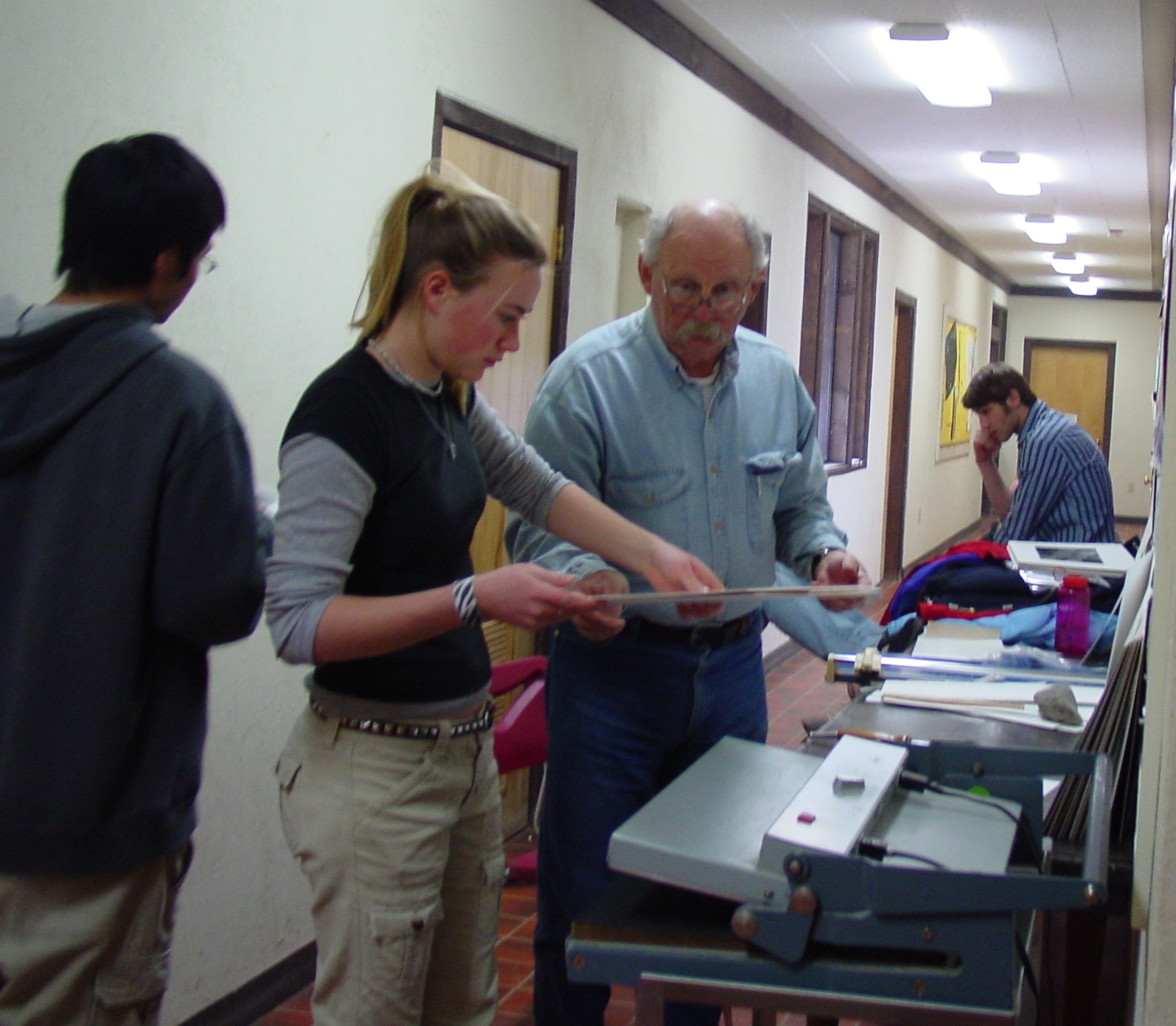 During her teaching career at the Orme School on the Quarter Circle V Bar Ranch, she taught Biology, Physics, History, Art, Horsemanship, and Flying, and established a unique program for the students, the
Orme Fine Arts Festival, bringing professional artists in many disciplines to teach the high school students for one week, an exciting experience both for the students, who begin to realize the fundamental importance of the arts, and that it is possible to have a career in Art. For the Teacher/Artists, it is an opportunity to enjoy the excitement of their own youth and forces that led them to their careers. This program, which has achieved national acclaim for the school, continues to this day.
During her teaching career at the Orme School on the Quarter Circle V Bar Ranch, she taught Biology, Physics, History, Art, Horsemanship, and Flying, and established a unique program for the students, the
Orme Fine Arts Festival, bringing professional artists in many disciplines to teach the high school students for one week, an exciting experience both for the students, who begin to realize the fundamental importance of the arts, and that it is possible to have a career in Art. For the Teacher/Artists, it is an opportunity to enjoy the excitement of their own youth and forces that led them to their careers. This program, which has achieved national acclaim for the school, continues to this day.
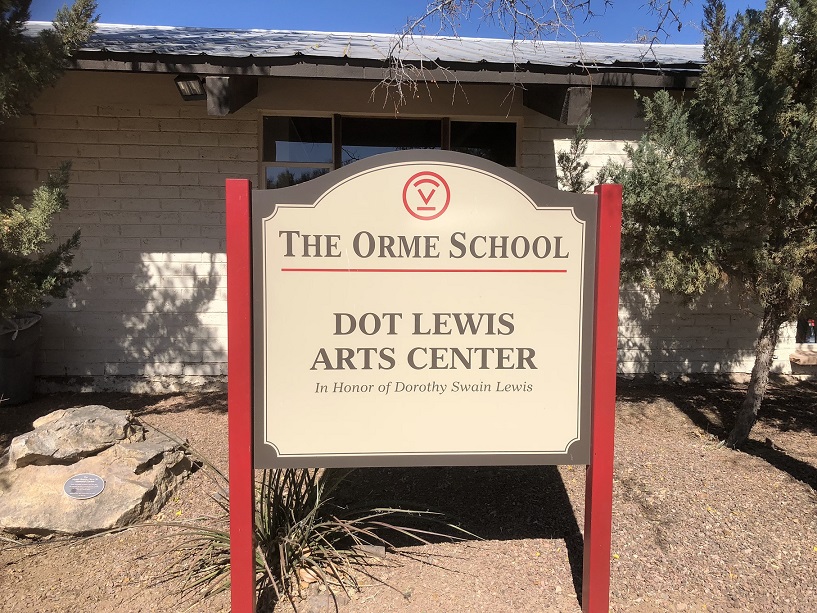 February 25 - March 3, 2018 was the 50th Anniversary of the Festival, featured a reunion of artists and participants, and the dedication on March 2nd of the new Orme School arts center, which has been named after its founder, and hosted an Exhibition of her works and those of several of the other Festival artists. The Reunion and Re-Dedication of the Festival was an enjoyable gathering of some of the past workshop leaders and a potential boost for the continuing improvement of the Arts program at Orme. It is hoped that the spirit of that dedication will continue throughout the history of the Orme School as it continues its mission to inspire students and teachers alike.
February 25 - March 3, 2018 was the 50th Anniversary of the Festival, featured a reunion of artists and participants, and the dedication on March 2nd of the new Orme School arts center, which has been named after its founder, and hosted an Exhibition of her works and those of several of the other Festival artists. The Reunion and Re-Dedication of the Festival was an enjoyable gathering of some of the past workshop leaders and a potential boost for the continuing improvement of the Arts program at Orme. It is hoped that the spirit of that dedication will continue throughout the history of the Orme School as it continues its mission to inspire students and teachers alike.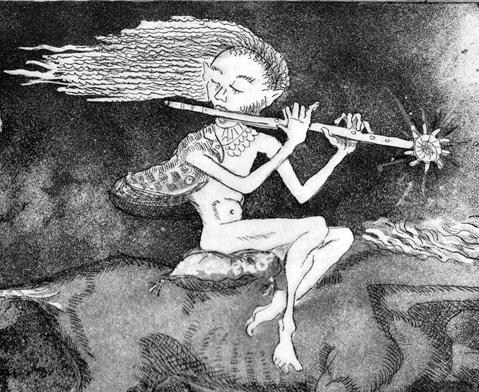
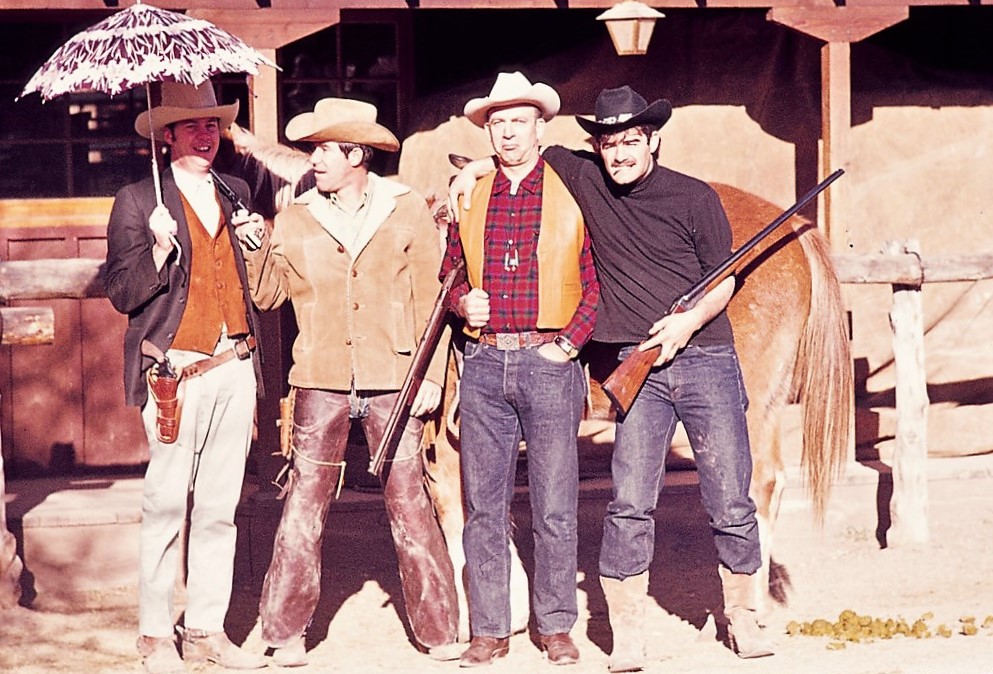
























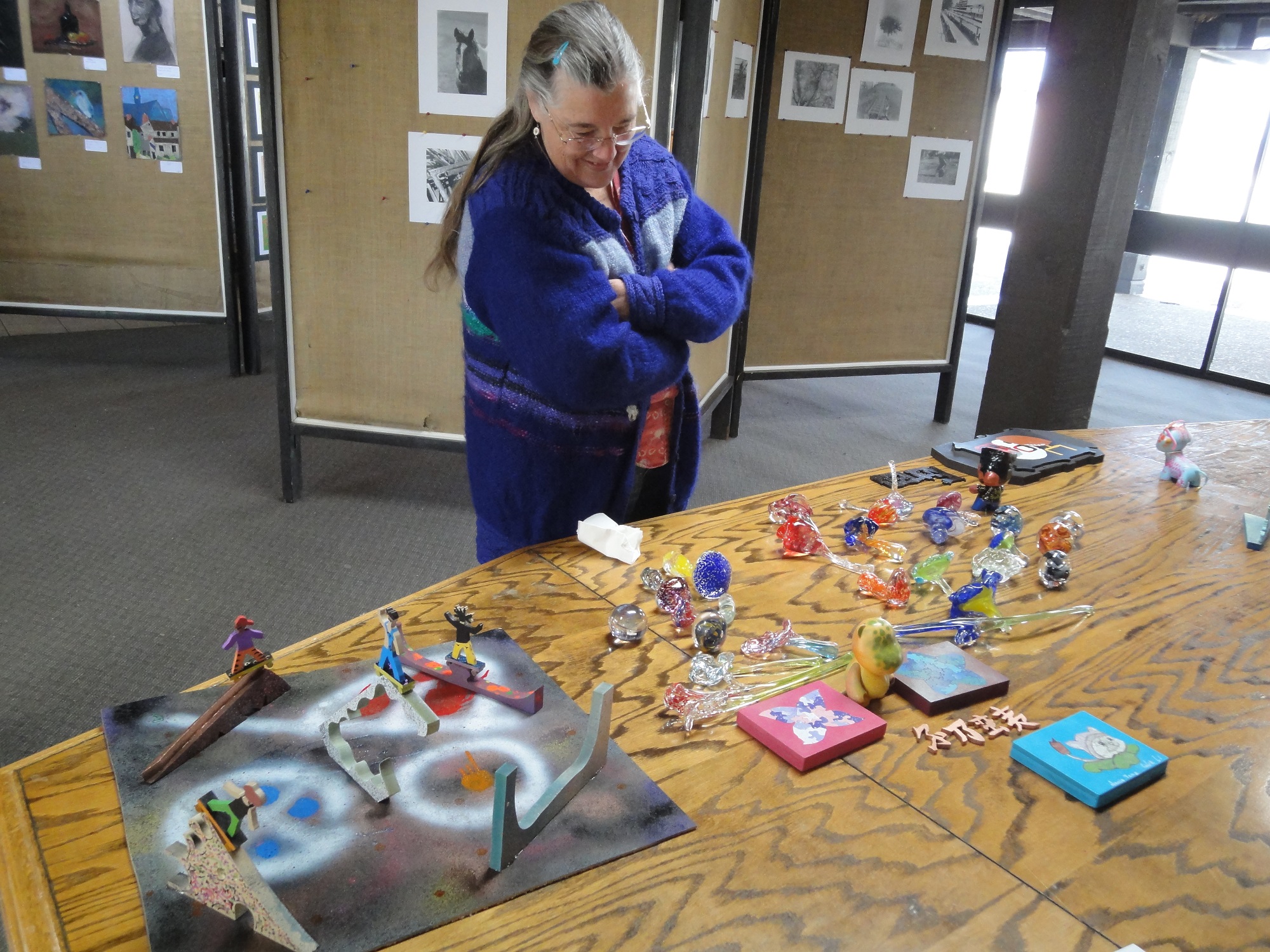
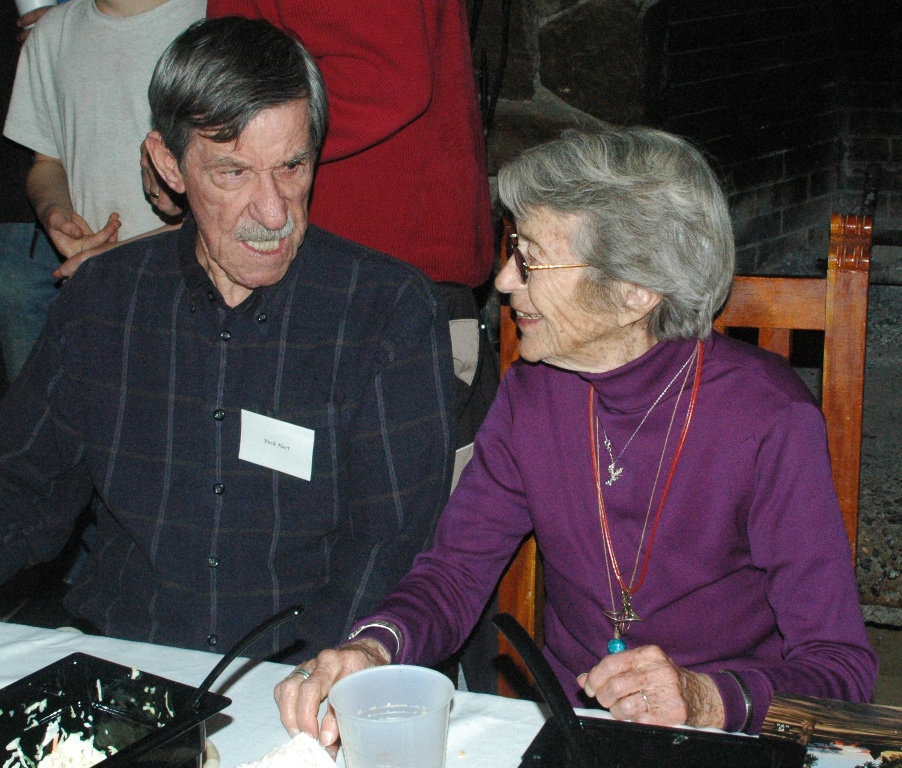 Buck Hart
Buck Hart